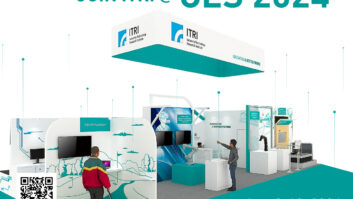NEW YORK –
Rising sales are prompting more
vendors to enter the cellphone and tablet markets
at next month’s International CES, where the Android
OS will dominate the introductions in both
platforms.
At least two vendors, including ViewSonic, will
enter the U.S. cellphone market at the show, where
Verizon Wireless is also expected to introduce
smartphones and other portable devices, including
video-optimized devices, incorporating 4G LTE
(Long Term Evolution) wireless-data technology.
Analysts doubt that Verizon will launch its own
iPhone at CES, expecting that announcement to
come at an Apple-organized event.
Most of the tablets on display will use the Android
OS; some will come with embedded ATSCM/
H (Mobile/Handheld) DTV tuners to turn them
into mobile TV sets; and at least one will feature glasses-free 3D.
About 35 companies will show tablet products or prototypes
at the show, Yankee Group analyst Dimitriy Molchanov
believes. Some of these companies — such as
Creative Labs, Augen, and ViewSonic — announced their
newest products in late 2010 and will show them for the
first time to the industry at large.
At least three other suppliers will come to the show
with expanded selections, and at least nine, and possibly
12, vendors will enter the U.S. tablet market at the show,
TWICE found in an unscientific survey of vendors planning
to show tablets at the show.
Many of the new tablets will feature a 7-inch display
compared to the iPad’s 10-inch screen, and by mid-
2011, said Strategy Analytics director Peter King, “we
should have a reasonable feel as to whether consumers
will opt for the more portable screen size or stay with the
industry benchmark 10-inch display.”
Sales of cellphones are also rising, but not at the
pace of tablets. Strategy Analytics projects 2.6 percent
growth in North American cellphone unit shipments in
2011, matching its projected 2010 growth rate.
Cellphone sell-in grew in 2010, thanks to the economic
recovery, smartphone demand that accelerated
the replacement cycle, net-new subscriber growth, and
expanding prepaid options, marketers told TWICE.
The value of cellphone shipments could grow faster
than unit growth, given the growing share of smartphones.
Strategy Analytics projects that smartphones’
share of unit cellphone sell-through in North America will
grow to 42 percent in 2011, from 35 percent in 2010.
The rapid growth of smartphones is driven by demand
at both the low and high ends, said analyst Alex Spektor.
At the high end, “superphones are resonating with
consumers looking for a premium-PC-like experience
on the go,” he said. “Operators are eagerly allocating
shelf share and subsidy-share to superphones because
of their ability to attract customers and drive data usage.
Handset vendors are attracted to the high gross margins
and strong volume growth of superphones.” He defined
superphones as offering screens that are 4 inches and
larger and processing speeds of 1GHz or more.
At the low end, carriers are making smartphones available
at low price points for the first time this year because
the phones require lower subsidies yet still drive
data usage and potentially attract consumers looking to
upgrade from feature phones, he said.
A growing selection of smartphones arriving next year
will feature 4G high-speed wireless-data technology, but
4G will also become a key feature in such connected
devices as tablets, mobile hotspots, e-readers and other
machine-to-machine [M2M] devices, marketers told
TWICE.
4G will also open up the market for entertainment
services to the handset, with Verizon Wireless having
already said that video would play a key role in its 4G
service, launched in December, marketers said.
Tablets will also play a role in the 4G plans of Verizon
and other carriers, marketers said, given tablets’ growing
popularity. Strategy Analytics projects U.S. retail sales of tablets will hit $6.84 billion in 2010, rising 40
percent in 2011 to $9.6 billion in 2011 before
falling to $9.1 billion in 2014 as unit sales continue
to grow but prices drop, thanks in large
part to carrier subsidies. “The [national] retail
selling price will be almost half of what it is
today by the end of 2014,” King said.
In 2010, the company forecasts 11.4 million
tablets will be sold at retail in the U.S. with an
average selling price of $600. Of that, Apple
will maintain a 75 percent unit share and 78
percent dollar share in the U.S.
Worldwide, 40 separate manufacturers by
November 2010 were offering 60 tablet SKUs,
and the list is growing each month. About
75 to 80 percent of those SKUs will hit U.S. shores, King predicted.
Tablet demand is strong, King said,
because consumers were “impressed
by the footprint together with the innovative
and compelling user experience,
particularly for browsing and media
consumption. Enterprises and vertical
markets have also been impressed.
“Many large corporations are trialing
tablets, and many more will do so when
more enterprise-oriented tablets such
as RIM’s Playbook appear on the market.”
Many enterprise executives view
the tablet as a larger communications
device rather than a smaller computing
device, he noted.
If the explosive tablet growth continues,
further cannibalization of the
e-reader market is inevitable, King added.
“Dedicated e-book readers have
already been hit, resulting in significant
price erosion during 2010 and the introduction
of hybrid models offering
some level of multimedia, even if only
web access.”
Tablets will also slow netbook
growth, he noted. “The strong rate of
growth enjoyed in the netbook market
(168 percent in 2009 and 41 percent in
2010) will slow and do well to achieve
double-figure percentage growth in
2011. While such strong early growth
is rarely sustained, we cannot overlook
the fact that despite being considerably
more expensive, the tablet does
provide a challenging alternative to the
netbook, especially to those who were
considering a netbook purchase due to
its portability.”
The tablet “is a real alternative” for
consumers who would have previously
bought a netbook to access the Internet
or email but not needing the productivity
applications. For these consumers,
the tablet is “the perfect coffee table
solution.”













